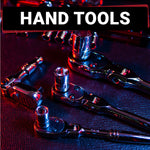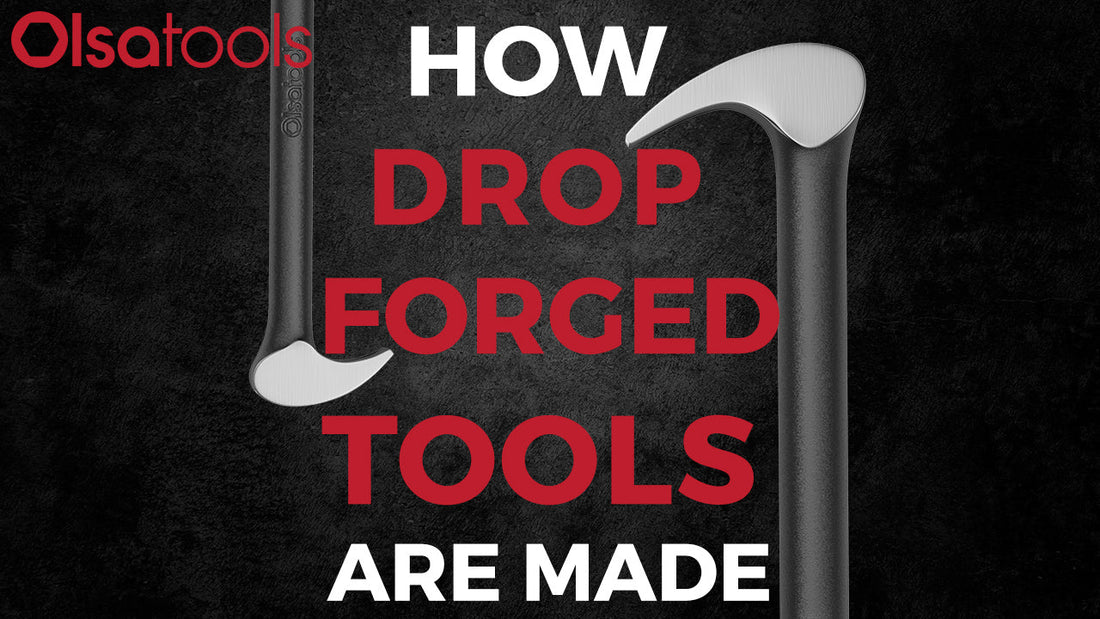Drop-forged involves dropping a heavy press onto hot metal to shape it. Drop-forged tools are among the strongest and most reliable in a mechanic's collection. Their manufacturing process dates back centuries, with modern technology bringing new precision to this time-tested technique.
We’ll tell you everything you need to know about drop-forging and why drop-forged tools are always worth purchasing.
What Is Drop Forging?
Drop forging stamps heated metal into shape through extreme pressure and precise machinery. This manufacturing method compacts the metal's internal structure to produce stronger tools than casting or machining processes.
A drop forge consists of two main components: a ram that delivers powerful downward strikes and a set of dies that shape the metal. The upper die attaches to the ram, which falls with tremendous force onto the lower die. Both dies contain impressions of the final tool shape.
The metal flows into these impressions under intense pressure, often exceeding 20,000 lb per square inch. This pressure alters the metal's grain structure at a molecular level, aligning grain patterns and eliminating internal voids and weaknesses.
Professional mechanics need tools with uniform strength and consistent performance. Drop forging delivers these qualities through its unique combination of heat and pressure, producing tools that mechanics trust for critical repairs and maintenance work.
The Raw Materials
Drop-forged tools start with specific metal alloys, typically chrome vanadium (Cr-V) steel, stainless steel, or chromium-molybdenum (Cr-Mo) steel. These alloys provide superior strength, durability, and resistance to wear. Manufacturers select metals with precise carbon content and alloying elements to create tools that withstand high stress and repeated use. Unlike casting, where molten metal is poured into molds, the metal remains solid during drop forging to improve durability.
The metal arrives as solid billets or bars, carefully quality-checked for consistent composition and structural integrity since even minor impurities can compromise tool performance under mechanical stress.
Heating and Forging
Manufacturers heat metal billets to temperatures between 900°C and 1200°C (1652°F to 2192°F), depending on the alloy. After reaching the desired temperature, workers transfer the hot metal to specialized dies for forging, where it is shaped under high pressure. The forged metal then cools gradually in the air, so the internal structure can be stabilized naturally.
Shaping and Forming
Hydraulic presses apply massive force to shape the metal. A powered hammer delivers repeated hammer blows until the metal fully conforms to the die’s shape. Powerful rams strike heated metal at pressures exceeding 20,000 lb per square inch.
Skilled workers might rotate and reposition the metal billet to create intricate tool features. As the process continues, the piece of metal gradually takes on the exact dimensions and contours of the final tool.
The result is a rough tool with incredible strength and uniform grain structure. Minimal material waste occurs compared to machining or casting methods.
Finishing Steps of the Drop-Forging Process
Once the drop-forged tools have been shaped and formed, they undergo a series of finishing steps to be sure they meet the highest standards of quality, durability, and functionality. These steps refine the tools' appearance, boost their performance, and prepare them for real-world use.
Quenching
Some manufacturers may opt for additional finishing steps such as quenching, a rapid cooling process that increases hardness but also brittleness. Others prefer controlled cooling or tempering to achieve an optimal balance of strength and ductility based on the tool's intended use. Each finishing method produces different combinations of hardness, toughness, and wear resistance.
Trimming and Deburring
Excess material, known as flash, may remain around the edges of the tool. This flash is trimmed away using specialized machinery. Any sharp edges or burrs are removed to make sure the tool is safe to handle and meets precise dimensional specifications.
Heat Treatment (Tempering)
While the initial heat treatment strengthens the metal, a secondary heat treatment process called tempering is often applied. This involves reheating the tool to a lower temperature and then cooling it slowly.
Tempering reduces brittleness while maintaining hardness, so the tool can withstand impact and stress without cracking.
Surface Finish
The tool's surface is smoothed and polished to improve its appearance and resistance to corrosion. Techniques such as grinding, sandblasting, or tumbling may be used to achieve the desired finish. This step also removes any remaining imperfections from the forging process.
Coating and Plating
To further boost durability and corrosion resistance, tools may be coated or plated with protective materials. Common coatings include:
- Black oxide: a corrosion-resistant finish that reduces light reflection.
- Chrome plating: a hard, shiny surface that resists wear and corrosion.
- Phosphate coating: improves lubricity and corrosion resistance, often used for tools exposed to harsh environments.
Marking and Branding
Manufacturers often engrave or stamp their logos, part numbers, and other identifying information onto the tools. This way traceability is provided and helps users identify the tool's specifications and origin.
Final Inspection
Before packaging, each tool undergoes a final inspection to verify its quality. This includes:
- Dimensional accuracy testing.
- Surface quality checks for scratches, dents, or other surface defects.
- Functional testing verifies that the tool performs as intended under simulated working conditions.
Packaging
The finished products are carefully packaged to protect them during shipping and storage. Packaging may include protective coatings, foam inserts, or plastic wraps to prevent damage and corrosion.
Open-Die vs. Closed-Die Forging
In open-die forging, heated metal is compressed between flat or simple dies so the metal can be worked and shaped by hand. This method suits large or simple-shaped parts but requires more finishing work.
Closed-die forging uses precision-machined dies that completely enclose the metal. As the press closes, the heated metal is pressed to fill the die cavity to create complex shapes with tight tolerances.
We use closed-die forging to make our wrenches. Here’s how:Find Out How Our Combination Wrenches Are Made! Here is a Close Look! - Olsa Tools
Who Uses Drop-Forged Tools?
Drop-forged tools power professional mechanics and serious DIY enthusiasts across multiple industries.
Automotive Sector
Mechanics rely on drop-forged wrenches, sockets, and pry bars for engine repairs, transmission work, and brake system maintenance. The tools withstand high torque demands and repeated impacts from pneumatic tools.
Construction and Industrial
Contractors use these tools for structural work, equipment maintenance, and heavy machinery repairs. Structural steel connections, pipeline installations, and industrial equipment assembly require tools that resist extreme stress.
Agricultural Machinery
Farmers and agricultural technicians depend on drop-forged tools to repair tractors, combines, and complex agricultural equipment. The tools survive harsh outdoor conditions and constant mechanical strain.
Aerospace and Transportation
Precision mechanics in aviation and transportation industries use drop-forged tools for critical equipment maintenance. Aircraft, trains, and marine vessels demand tools with zero margin for structural failure.
Motorsports and Racing
High-performance racing teams use drop-forged tools that can withstand rapid, repeated adjustments under extreme conditions. Pit crews need tools that perform perfectly during split-second mechanical interventions.
Metalworking and Fabrication
Welders, machinists, and metal fabricators require tools that maintain precise tolerances under continuous use. Drop-forged tools provide the durability needed for cutting, shaping, and assembling metal components.
What Are Examples of Drop-Forged Tools?
Drop-forged tools appear throughout every professional mechanic's toolbox. From simple hammers to complex ratchets, the manufacturing process produces durable tools that mechanics trust for their toughest jobs.
- Wrenches and ratchets are the most used drop-forged tools. The forging process creates wrenches with strong beam sections and precise openings that grip fasteners without slipping. The ratchet heads acquire exceptional durability through compression of the metal's grain structure.
- Socket sets benefit from drop forging's ability to produce exact dimensions. The process forms sockets with precise internal geometries that distribute torque evenly across fastener faces.
- Pliers and grip tools require both strength and precision. Drop forging creates plier jaws that maintain their grip surfaces through repeated use. The compressed metal structure prevents jaw misalignment and provides consistent gripping force across the tool's lifetime.
- Impact tools face extreme force during use. Drop-forged impact sockets and extensions absorb repeated shock loads without cracking. The dense grain structure created during forging disperses impact forces throughout the tool body.
- Hammerheads must withstand thousands of high-force strikes. Drop forging aligns the metal's internal structure to resist deformation and prevent chipping. The process creates hammer faces that maintain their shape and striking surface characteristics over years of use.
How To Identify Drop-Forged Tools
Professional mechanics spot drop-forged tools through specific physical traits and markings. These identification points separate high-quality drop-forged tools from tools manufactured through other methods.
- Product labeling includes direct references to the forging process. Tools display "drop forged" stamps, material specifications, manufacturing location, and compliance marks that certify treatment.
- Visible parting lines appear where forging dies meet during manufacturing. The lines create a subtle ridge on tool surfaces, most noticeable near edges and corners. These marks indicate die alignment during forging.
- Material characteristics reveal the dense, non-porous structure unique to drop forging. The metal shows consistent color, smooth surfaces without voids or bubbles, and develops even wear patterns through use.
Why You Should Buy Drop-Forged Tools
Professional mechanics invest in drop-forged tools for one reason: these tools last. The manufacturing process creates tools that outperform other production methods in strength, wear resistance, and reliability.
- Drop-forged tools deliver superior strength through compressed metal structures. The forging process packs metal molecules tightly together, eliminating internal weaknesses found in cast or machined tools. Our wrenches withstand three times more torque than standard cast tools.
- The metal grain structure is aligned throughout drop-forged tools. The forging process arranges metal fibers in patterns that resist breaking and improve tensile strength. This internal structure prevents structural failure under extreme force.
- Wear resistance increases through the dense molecular structure. Chrome vanadium steel in Olsa drop-forged tools maintains crisp edges and precise dimensions even after years of daily use in professional shops.
- Drop-forged tools perform reliably under constant stress. Each Olsa tool undergoes testing to professional standards, proving its ability to handle repeated torque, impact, and pressure without deformation.
- The long-term value of drop-forged tools outweighs the initial cost. Olsa delivers truck-tool quality at lower prices, reducing replacement frequency while maintaining professional performance standards.
Drop-Forged Products by Olsa Tools
12-Piece Ratcheting Wrench Set
Professional mechanics need high-quality tools that withstand daily abuse. Our 120-tooth ratcheting wrench set delivers professional performance at a fraction of premium brand prices.
Cr-V steel construction provides unmatched durability. Each wrench features a slim profile for accessing tight spaces and a high tooth count for smooth, efficient operation.
Adjustable Wrench
Forged from high-strength steel, the Olsa Tools adjustable wrench tackles complex mechanical tasks with ease. Wide jaw capacity and precise adjustment mechanisms allow mechanics to grip fasteners from 0 to 1.5 inches.
Rolling Head Pry Bar
Mechanics require tools that can handle challenging work environments. Our rolling head pry bar provides unparalleled leverage and flexibility. The drop-forged design allows for precise pivoting and angle adjustments.
A Cr-V steel core resists bending and maintains structural strength during heavy-duty applications.
Drop-Forged Tools FAQ
What are the disadvantages of drop-forged steel?
Drop-forged steel tools cost more to produce than cast tools. The manufacturing process requires specialized equipment and skilled labor. Complex tool shapes can be challenging to create through drop forging.
What is the difference between forged and drop forged?
Drop forging is a specific type of forging that uses a raised hammer or ram to strike heated metal into dies. Traditional forging methods may use different techniques such as press or hammer with varied force applications.
What is better than forging?
Forging produces the strongest steel products. Other manufacturing methods have their strengths: CNC machining offers precision and 3D printing enables complex geometries. But forging provides superior strength and grain structure.
Is forging still used today?
Forging is still used today and it powers modern manufacturing. Automotive, aerospace, military, and precision tool industries require forged components. Modern drop-forging techniques incorporate computer-controlled precision to meet exact manufacturing specifications.
Advanced technologies have refined forging methods. Manufacturers now produce more precise and efficient metal parts through innovative techniques.
Who invented forging?
Forging originated in ancient civilizations around 4000 BCE. Mesopotamian and Egyptian metalworkers were among the first to hammer and shape metal using basic forging techniques. The process evolved through Bronze Age and Iron Age metalworking traditions. Skilled blacksmiths have worked with hot iron for centuries to refine techniques that modern manufacturers still use today.
What is cold forging?
Cold forging shapes metal at room temperature through high-pressure compression. Manufacturers press a block of metal into dies without heat. This process creates precise components with tight dimensional tolerances.
Cold forging is used for softer metals such as aluminum, copper, and mild steel. The technique produces parts with smooth surfaces and stronger mechanical properties.








